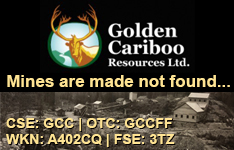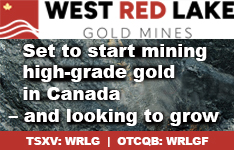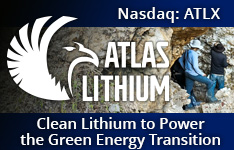Cecil Musgrave: Uranium prices sold off sharply after the Fukushima Daiichi nuclear power plant accident in March 2011, and have steadily drifted lower since then, from around $70 per pound ($70/lb) to its current price of around $43/lb. My charts say that uranium may have put in its bottom last November before bouncing over 10% on the back of Japan's election in December.
Since Fukushima, market sentiment for anything nuclear power related, like uranium, has been risk-off. While time was needed to stress test nuclear plants worldwide, the market's main concern was how the media, the public and governments around the world would react. But the facts continue to be on the side of nuclear power as a practical solution for a growing world that requires abundant, low-cost and environmentally safe energy.
Despite uranium's long-term fundamentals, which have never looked better, markets hate short-term uncertainty. I see this as mainly a timing issue. The World Nuclear Association shows there are 435 operable nuclear reactors today, with 65 more under construction, 167 in the planning stages and 317 more proposed as of January 2013.
Markets tend to exaggerate trends, both up and down. After a steep selloff in uranium that lasted almost two years, sentiment seems to be starting to swing positively again. Japan now has a pro-nuclear government; two of Japan's reactors are back online and the recent elections may accelerate this process. Last February, the U.S. approved the construction of a two-unit nuclear power plant at the Vogtle complex in Georgia—this is the first new nuclear reactor to be built in the U.S. in over three decades.
China will be a key uranium demand driver—16 reactors are operating now, 29 under construction, 51 planned and 120 proposed. Other demand-generating countries include India, Russia, the U.A.E., Ukraine, the U.K., Canada and South Korea.
The supply side is also bullish. Lower prices have put the brakes on several large uranium developments. BHP Billiton Ltd. (BHP:NYSE; BHPLF:OTCPK) deferred the expansion of its Olympic Dam mine in Australia—the world's largest-known single deposit of uranium. Cameco Corp. (CCO:TSX; CCJ:NYSE) deferred its Kintyre project—also located in Australia. Paladin Energy Ltd. (PDN:TSX; PDN:ASX) deferred an expansion at its Langer Heinrich mine in Namibia. Kazatomprom and Uranium One Inc. (UUU:TSX) decided it would be uneconomic to mine at its Zarechnoye South deposit in Kazakhstan. Many smaller uranium miners are in the same situation.
I doubt that the absence of this previously anticipated supply has been factored into uranium's current price. Keep in mind that the 2007 uranium price spike to $137/lb was probably due in part to flooding and production delays at Cameco's Cigar Lake mine in Canada—the world's largest undeveloped high-grade uranium deposit. Mine commissioning is now expected mid-2013.
Annual uranium demand is ~180 million pounds (180 Mlb) with ~140 Mlb mined. Much of that ~40-Mlb supply shortfall has been made up for by the Megatons to Megawatts program, wherein uranium from Russia's nuclear warheads is recycled. This program is scheduled to end later this year, further straining global uranium supply.
Uranium mining is highly regulated and even if the price spiked again, it would take years to put those deferred mines into production. In addition, the TSX Venture market has been cut in half over the past two years, making it very tough for junior explorers to fund new projects. I'd be surprised if uranium prices weren't significantly higher a year from now.
TER: Over the last few years, how has utilities' increased use of natural gas affected the price of uranium? How does uranium compare to traditional energy fuels and alternative energy sources in terms of efficiency?
CM: Traditional energy fuels such as coal, oil and natural gas are substitutes, in that a cheaper fossil fuel can often be used when another becomes expensive. But it takes time and costs millions for a utility to switch, and you still end up burning an inefficient fuel that pollutes the air. Uranium is a metallic chemical element that is extremely energy dense, making it a very inexpensive fuel. Uranium is also the only commercially available fuel source for nuclear power plants. Unlike fossil fuel-burning power plants, nuclear power plants do not emit harmful gasses, and all the spent nuclear fuel produced for one person's lifetime would fit in one soda can, about 2 lb of waste. A typical U.S. power plant for a city of one million people might burn 9,000 tons of coal or 40,000 barrels (bbl) of oil per day. For a nuclear power plant this might take 7 lbs of uranium. At $90/barrel oil and $43/lb uranium, the daily fuel cost works out to $3,600,000 for oil versus $301 for uranium.
Fuel costs are not the major concern for nuclear power utilities, even if uranium prices went up ten-fold. Capital costs and interest rates are the larger obstacles. Nuclear power plants are designed to last decades, but they can't switch fuel sources, so securing long-term uranium supply is important.
In addition to being efficient, nuclear power is also reliable. This is where nuclear energy even trumps renewables. The world's largest net exporter of electricity is France, which produces around 80% of its power from nuclear reactors. Italy is next door, has no nuclear reactors, and is the world's largest importer of electricity. Germany shut down some reactors and now imports more electricity. When there's no wind in the U.K. to turn the turbines, electricity is sent via the Chunnel.
Alternative energy from renewable sources produces around 16% of the world's energy, from wind, solar, geothermal, hydroelectricity, biomass and others—combined. This is small, but it's growing and needs to be part of the world's future energy mix.
Renewables have advantages in certain situations, but also disadvantages. These range from higher footprints and capital costs, to lower efficiency and reliability. I see nuclear power and uranium as the "sustainability bridge" that will allow for a transition away from burning dirty fossil fuels, while buying time for renewable energy forms to become a competitive alternative.
TER: In a capital-constrained market, how are firms looking to lower the cost of uranium mining? Can In-Situ Recovery (ISR) development affect the growth of global supplies of uranium without undermining price?
CM: Over 45% of the world's uranium is now produced using this low-cost, environmentally friendly mining method. However, ISR is only amenable in certain situations, ideally to mine uranium-mineralized sandstone deposits that are confined in an aquifer.
Compared to underground or open-pit mining, ISR is an elegant process. A leaching solution of carbon dioxide, baking soda and oxygen is injected into the sandstone ore, dissolving the uranium. This is then pumped out and ionized pellets are added, which the uranium bonds to. These pellets are then stripped of the uranium for further processing. After processing the yellowcake, the inert material leftover is returned to the ground.
From a financial perspective, U.S. ISR requires less labor, capital and operating costs, and mines are faster to permit and construct. From an environmental perspective, it's cleaner and safer with less of a footprint and no leach pads if a deep disposal well is employed. These savings can boost ISR uranium mine margins to be profitable even at low ore grades. I can't think of a reason why a uranium miner wouldn't use ISR given the option.
TER: How are the large uranium companies weathering the present situation?
CM: As I mentioned earlier, several major uranium producers have had to defer some of their projects due to low prices. The decision to put some of these mines back into development probably won't happen until uranium prices double, and production would still lag behind that occurrence.
However, these companies still have a lot of production from other mines. In November, Uranium One Inc. announced a Q3/12 production increase of 23% to 3.1 Mlb, with average cash costs of $16/lb and $49/lb for sales. Cameco is the world's largest publicly traded uranium company and its Q4/12 and FY/12 results will be released February 8.
While every uranium company is rationalizing costs around lower current prices, those companies that can still afford it are also positioning for higher future prices. Cameco just completed its NUKEM Energy acquisition, a leading nuclear fuel broker. It completed its $430 million ($430M) Yeelirrie acquisition, a Western Australia uranium project, last month. And just last week, Uranium One announced an agreement with its majority shareholder, ARMZ Uranium Holding Co., to go private at a 32% premium to its 20-day, volume-weighted average share price.
Others are weathering lower uranium prices by doing creative financings that are less dilutive to shareholders. Utilities benefit as well by locking in lower prices and securing future uranium supplies. Last fall, Paladin signed a long-term supply contract with Électricité de France (the world's largest nuclear utility) with a prepayment of $200M.
TER: For investors interested in the uranium space, what are the comparative advantages of investing directly in uranium majors, juniors, holding companies or exchange-traded products (ETFs)?
Similar to the metals investing space, the major producers in the uranium sector may offer more safety, earnings transparency, diversified projects and market liquidity relative to small miners. On the other hand, junior uranium explorers offer higher risk/reward potential that usually depends on successfully discovering and/or developing key resources.
Uranium is radioactive and can't be physically held like gold bullion. The uranium futures market is not as developed or as liquid as those for most other commodities. There are various ETFs and holding companies, such as Uranium Participation Corp. (U:TSX), which invests in uranium-oxide concentrates or uranium hexafluoride stored in licensed facilities and is managed by a subsidiary of Denison Mines Corp. (DML:TSX; DNN:NYSE.MKT).
I tend to focus on uranium companies somewhere in the middle that carry some of the safety from having experienced management, funding, established resources and a mine in development, but that are also small enough that drill results impact share prices meaningfully.
TER: Are there any small-cap firms that are positioned to do well in the current market? Where can investors look for opportunities?
CM: Canada is second only to Kazakhstan in uranium production. The Athabasca Basin in Northern Saskatchewan/Alberta contains the world's largest high-grade uranium deposits and supplies 20%+ of the world's uranium. Production is expected to double by 2017.
In 2011, Cameco and Rio Tinto Plc (RIO:NYSE; RIO:ASX; RIO:LSE; RTPPF:OTCPK) were in a bidding war over uranium explorer Hathor Exploration Ltd. Rio Tinto won with a CA$654M buyout offer. Since then, I have watched Fission Energy Corp. (FIS:TSX.V; FSSIF:OTCQX) report decent grades and resources from various properties, including some in close proximity to Hathor's high-grade Roughrider deposit.
Fission's market-cap is under $100M; its stock price was cut almost in half last year with the rest of the uranium juniors, but has been showing strength again since November—then added to our website's Top 30 Watchlist. Earlier this month, Fission announced a $5.5M winter exploration program at its 60% owned 40,000 hectare (40k-ha) Waterbury Lake project, drilling 21,000 meters (21k-m) over 60 holes utilizing three drill rigs at its J-Zone high-grade uranium discovery.
A week later, Fission announced a $4M winter program at its 50% owned 31k-ha Patterson Lake South (PLS) project, drilling 8k-m utilizing two drill rigs toward extending its high-grade uranium boulder field discovery.
But now I see that Denison Mines intends to acquire Fission Energy, including its eastern Athabasca assets and Waterbury Lake. Under the deal, Fission shareholders get Denison shares, plus shares in a new, funded spinout company to hold Fission's western Athabasca assets including PLS.
There are around 75 companies of all sizes exploring in the Athabasca Basin and other prolific uranium-mining districts, such as the Powder River Basin in Wyoming. Some will mine their own uranium discoveries, but I doubt that Hathor will be the last takeover battle.
TER: Are there any other juniors that investors should be considering?
CM: Uranium Energy Corp. (UEC:NYSE.MKT) has a market-cap of ~$200M with projects in the Powder River Basin in Wyoming, plus properties in four southwestern U.S. states and in Paraguay. Uranium Energy's focus is in south Texas, where it is ramping up production at its Hobson processing plant and Palangana ISR mine and its Goliad ISR project is fully permitted and in construction.
Ur-Energy Inc. (URE:TSX; URG:NYSE.MKT) has a market-cap of ~$108M with projects in Wyoming and Nebraska, and in the Thelon Basin of Canada's Northwest Territories. The company's focus is its Lost Creek ISR uranium project just south of the Powder River Basin that started construction in October.
Uranerz Energy Corp. (URZ:TSX; URZ:NYSE.MKT) has a market-cap of ~$118M with projects focused in the Central Powder River Basin. Uranerz controls ~90k acres there, with its latest NI 43-101 resource report showing over 15 Mlb in the Measured and Indicated category and over 3 Mlb Inferred from just seven out of 30 projects explored so far. In June, Uranerz discovered a new uranium trend at its Monument project.
Uranerz is near completion of its first ISR mine and processing plant—permitted for up to 2 Mlb per year and expected to begin production this year. In October, Uranerz received its last permit needed, and is drilling two deep disposal wells this winter. Nichols Ranch will become the first new uranium mine built in Wyoming since 1996, and will serve to develop the company's satellite projects more quickly under the existing permit amendment provisions. Uranerz has an experienced team, many from another uranium miner that was also called Uranerz—purchased by Cameco in the late 1990's. A few years ago, when uranium prices were higher, Uranerz signed sales agreements with Excelon Corp. (EXC:NYSE) and another major utility. Late in 2011 Uranerz signed an agreement for final processing at Cameco's PRB Smith Ranch Highland mine. Equity financing for mine construction was done when Uranerz traded at triple its current price, and permitting has also been timely.
This property map shows that Uranerz Energy, Uranium One and Cameco's uranium properties in the Central Powder River Basin in Wyoming surround each other. In the U.S.A., Wyoming is the largest uranium-producing state. Our December newsletter highlights Wyoming's pro-business advantages, including around $600M earmarked from its surplus budget to help local businesses grow faster. Uranerz and Ur-Energy have been approved for $20M and $34M loans, respectively.
TER: Your Investors Guru newsletter does not set target prices for particular stocks. Do you have any advice on what metrics investors should use when deciding when to buy and sell shares in uranium producing ventures?
My background is in computers, business, and in the 1990s the brokerage industry. I started InvestorsGuru.com in 1995 as a new way for fellow investors to share market news, data and ideas. This was before most of the financial sites we know today, and before online social sharing became a household practice. We're not trying to be an advisory service—we're more like a very big investors club.
Personally, I first look at the industry. I tend to focus more on long-term growth than I did 20 years ago. I started looking at the uranium industry more in 2010 because I didn't have many energy holdings. This was because a junior oil stock that I owned, that found thousands of barrels per day in Libya, was bought out at a slight loss instead of the pop that I had anticipated.
Uranium is an energy commodity but it is also a mined metal. Our Small-Cap Stock Observer newsletter has featured mining companies since the Voisey's Bay Nickel-Cobalt boom, to diamond discoveries in Canada, to gold and other deposits worldwide. As they say, stick to what you know and what's working, and learn all you can.
Major uranium producers are widely followed. Small-cap uranium companies often don't have earnings, so you have to get to know the company beyond reading press releases. I look for scalable, well funded projects with experienced management and lots of activity—a lack of news for too long is enough for most small-caps to drift lower. Finally, call the company; request its investor package!
Once I decide to get in (or out of) an industry or a particular stock, various technical charts help refine my exact timing. I look for support and resistance levels and trends that are building or breaking down.
I believe that if individual investors put the time in, they can outperform most brokers and fund managers. I'm not just talking about doing research; you also need to really know yourself—your objectives and risk tolerance. This defines your time horizon and asset allocation, and from there you can focus on individual stocks and investments.
Our site's Research tab has information on various commodities—uranium is under "Other Energy." Our searchable Small-Cap Directory lists over 500 companies under $500M market-cap—including 57 uranium stocks.
TER: Thank you for sharing your uranium industry overview with us.
CM: My pleasure.
Cecil Musgrave founded InvestorsGuru.com and the Small-Cap Stock Observer newsletter in 1995 as a new way for investors and companies to share ideas and news—before most financial or social sites existed. Musgrave was a retail and institutional advisor licensed in all securities including options and futures and is a Certified Investment Manager and Fellow of the Canadian Securities Institute. He holds a Bachelor's degree in computer science and has served as a public mining company director and has owned and operated a number of private businesses.
Want to read more Energy Report interviews like this? Sign up for our free e-newsletter, and you'll learn when new articles have been published. To see a list of recent interviews with industry analysts and commentators, visit our Interviews page.
DISCLOSURE:
1) Peter Byrne of The Energy Report conducted this interview. He personally and/or his family own shares of the following companies mentioned in this interview: None.
2) The following companies mentioned in the interview are sponsors of The Energy Report: Fission Energy Corp., UR-Energy Inc. and Uranerz Energy Corp. Interviews are edited for clarity.
3) Cecil Musgrave: I personally and/or my family own shares of the following companies mentioned in this interview: Uranerz Energy Corp. I personally and/or my family am paid by the following companies mentioned in this interview: Uranerz Energy Corp. The company was not publicly traded at that time. I was not paid by Streetwise Reports for participating in this interview.










































